The Intel Optane Memory M10 (64GB) Review: Optane Caching Refreshed
by Billy Tallis on May 15, 2018 10:45 AM EST- Posted in
- SSDs
- Storage
- Intel
- PCIe SSD
- SSD Caching
- M.2
- NVMe
- Optane
- Optane Memory
Sequential Read Performance
Our first test of sequential read performance uses short bursts of 128MB, issued as 128kB operations with no queuing. The test averages performance across eight bursts for a total of 1GB of data transferred from a drive containing 16GB of data. Between each burst the drive is given enough idle time to keep the overall duty cycle at 20%.
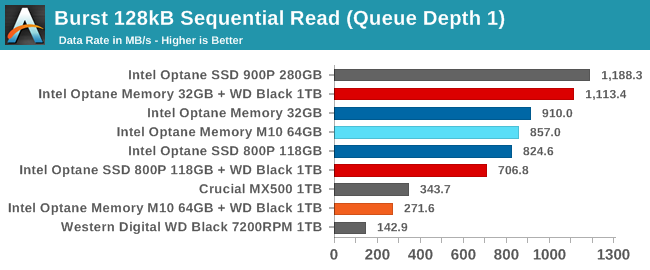
The burst sequential read results are bizarre, with the 32GB caching configuration coming in second only to the Optane SSD 900P while the large Optane M.2 modules perform much worse as cache devices than as standalone drives. The caching performance from the 64GB Optane Memory M10 is especially disappointing, with less than a third of the performance that the drive delivers as a standalone device. Some SSD caching software attempts to have sequential I/O bypass the cache to leave the SSD ready handle random I/O, but this test is not a situation where such a strategy would make sense. Without more documentation from Intel about their proprietary caching algorithms and with no way to query the Optane Memory drivers about the cache status, it's hard to figure out what's going on here. Aside from the one particularly bad result from the M10 as a cache, all of the Optane configurations do at least score far above the SATA SSD.
Our test of sustained sequential reads uses queue depths from 1 to 32, with the performance and power scores computed as the average of QD1, QD2 and QD4. Each queue depth is tested for up to one minute or 32GB transferred, from a drive containing 64GB of data.
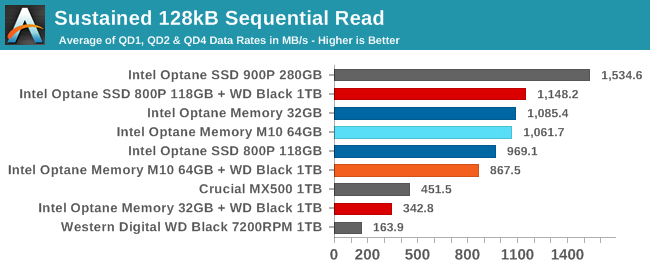
The sustained sequential read test results make more sense. The 32GB cache configuration isn't anywhere near large enough for this test's 64GB dataset, but the larger Optane M.2 modules offer good performance as standalone drives or as cache devices. The 64GB Optane Memory M10 scores worse as a cache drive, which is to be expected since the test's dataset doesn't quite fit in the cache.
 |
|||||||||
Using an 118GB Optane M.2 module as a cache seems to help with sequential reads at QD1, likely due to some prefetching in the caching software. The 64GB cache handles the sustained sequential read workload better than either of the sustained random I/O tests, but it is still slower than the SSD alone at low queue depths. Performance from the 32GB cache is inconsistent but usually still substantially better than the hard drive alone.
Sequential Write Performance
Our test of sequential write burst performance is structured identically to the sequential read burst performance test save for the direction of the data transfer. Each burst writes 128MB as 128kB operations issued at QD1, for a total of 1GB of data written to a drive containing 16GB of data.
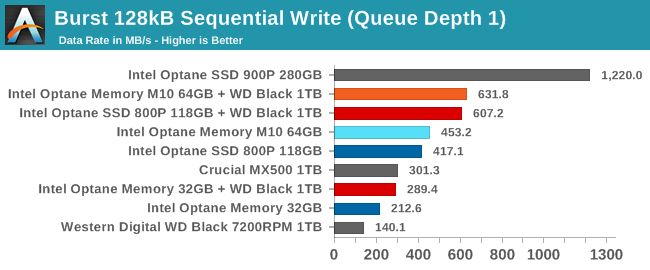
As with the random write tests, the cache configurations show higher burst sequential write performance than testing the Optane M.2 modules as standalone SSDs. This points to driver improvements that may include mild cheating through the use of a RAM cache, but the performance gap is small enough that there doesn't appear to be much if any data put at risk. The 64GB and 118GB caches have similar performance with the 64GB slightly ahead, but the 32GB cache barely keep up with a SATA drive.
Our test of sustained sequential writes is structured identically to our sustained sequential read test, save for the direction of the data transfers. Queue depths range from 1 to 32 and each queue depth is tested for up to one minute or 32GB, followed by up to one minute of idle time for the drive to cool off and perform garbage collection. The test is confined to a 64GB span of the drive.
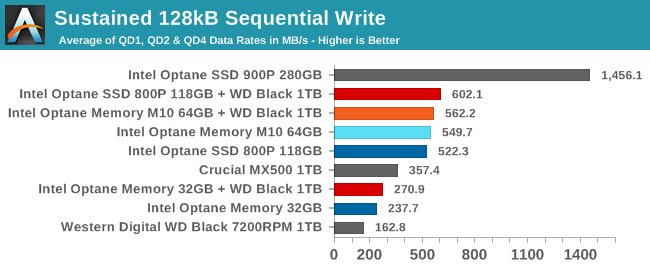
The rankings on the sustained sequential write test are quite similar, but this time the 118GB Optane SSD 800P has the lead over the 64GB Optane Memory M10. The performance advantage of the caching configurations over the standalone drive performance is smaller than for the burst sequential write test, because this test writes far more data than could be cached in RAM.
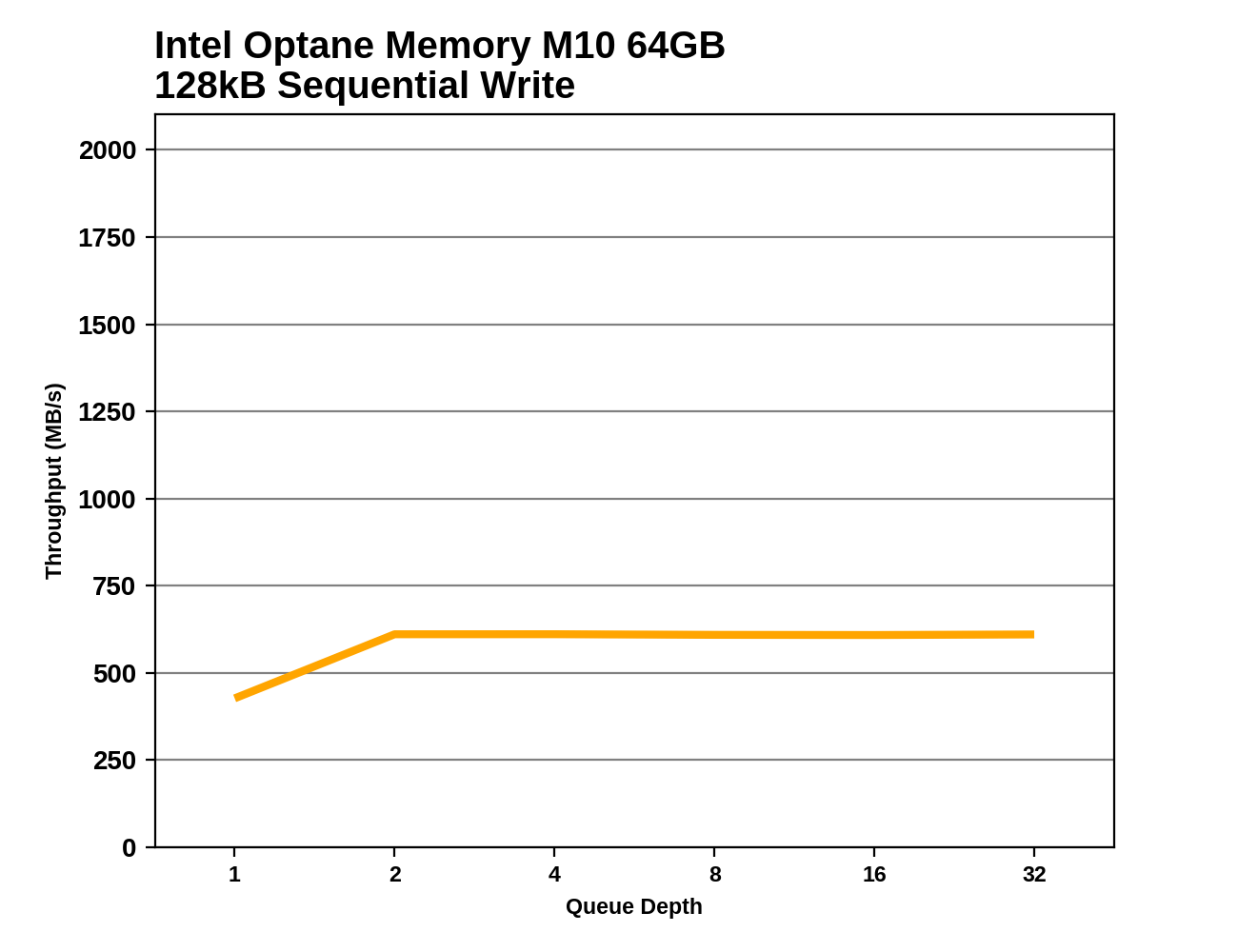 |
|||||||||
Aside from some differences at QD1, the Optane M.2 modules offer basically the same performance when used as caches or as standalone drives. Since this test writes no more than 32GB at a time without a break and all of the caches tested are that size or larger, the caching software can always stream all of the writes to just the Optane module without having to stop and flush dirty data to the slower hard drive. If this test were lengthened to write more than 32GB at a time or if it were run on the 16GB Optane Memory, performance would plummet partway through each phase of the test.










96 Comments
View All Comments
Flunk - Tuesday, May 15, 2018 - link
For $144 you can get a 256GB M.2 SSD, big enough to use as a boot drive. Even as a cache for a slow hard-drive (which means you also need to buy a hard drive, possibly bumping the cost up to 512GB SSD prices) means this product doesn't make any sense at all. Maybe it made sense when they started development, but it doesn't now.dullard - Tuesday, May 15, 2018 - link
Flunk, the reason to get these drives is that an Optane cache + standard hard drive is FASTER and LARGER CAPACITY than the 512 GB SSD. If you don't like larger or faster, then go ahead with just a SSD.bananaforscale - Tuesday, May 15, 2018 - link
You totally miss the point. An SSD is cheaper and irrelevantly slower and you can use it for caching.wumpus - Wednesday, May 16, 2018 - link
You can? You used to be able to use a 64GB cache on Intel boards, and you can use a 512GB cache on just released AMD (470) boards [unfortunately, that bit of the review still has [words] under the storeMI section].If you can pull it off, a 512GB caching SATA drive makes all kinds of sense for anything you might want to do with this. As near as I can tell, Optane's only advantage is that they provide the caching software without having to hit windows and motherboard requirements. Which makes the whole "optane is so fast" advantage a bit of a joke.
Wake me up when optane has the endurance to be used with a DDR4 interface (presumably with caching HBM2/Intel system DRAM). This doesn't give any advantage (besides providing the software license).
shadowx360 - Wednesday, May 23, 2018 - link
Windows Storage Spaces or ZFS can do it. Right now I have 2x256GB SSDs mirrored to accelerate a 5x4TB hard drive array. I set 100GB as a write-back cache that automatically flushes to the HDDs, so random write is SSD-level quick. I also pin about 20GB of files to the SSDs permanently and the rest is rotated between free space and system-managed hot files.Lolimaster - Tuesday, May 15, 2018 - link
400-500MB/s vs 1.5GB/s, not really much of a difference, either way you will have to wait for that HDD to write to the cache drive 1st at 100MB/s or less (since they're small files, HDD works faster on transfer with larger files).If you got a set of constantly used files, move those to the SSD, problem solved.
evernessince - Wednesday, May 16, 2018 - link
Or you buy an X470 motherboard or pay $10 to get StoreMI, which also makes a cache but is much cheaper and can use any SSD as a cache, which saves you money, allot of it.CheapSushi - Wednesday, May 16, 2018 - link
You can use any Optane drive like ANY SSD too.Spunjji - Wednesday, May 16, 2018 - link
It's faster in zero real-world situations. It's larger than an SSD bought for the same total money, but not larger than an SSD at the same cost as the optane drive (256GB) + the same HDD you'd use for optane caching. Your point is... flawed.Keljian - Tuesday, May 29, 2018 - link
This is actually not true. It's faster for Mysql/sqlite in 4k situations when the cache is tuned for it. What uses sqlite? - games, most office software, web browsers..